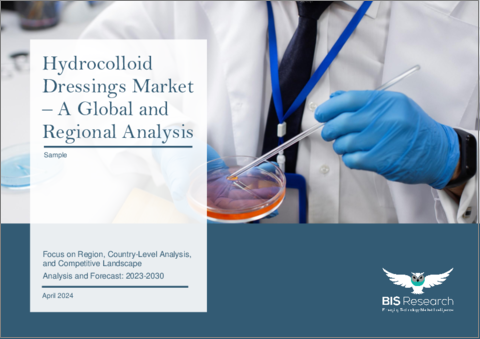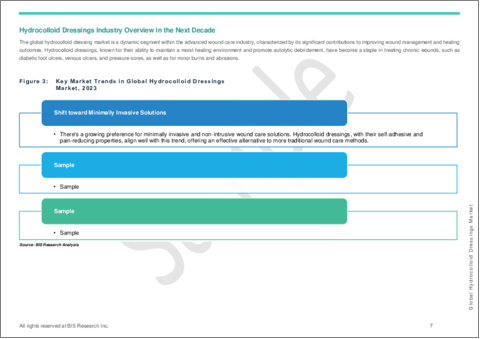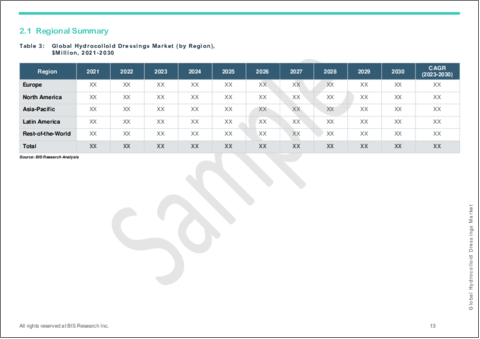|
|
市場調査レポート
商品コード
1471863
ハイドロコロイドドレッシング市場:世界および地域別分析:地域別・国別分析、競合情勢:分析と予測(2023年~2030年)Hydrocolloid Dressings Market - A Global and Regional Analysis : Focus on Region, Country-Level Analysis, and Competitive Landscape - Analysis and Forecast, 2023-2030 |
||||||
カスタマイズ可能
|
|||||||
| ハイドロコロイドドレッシング市場:世界および地域別分析:地域別・国別分析、競合情勢:分析と予測(2023年~2030年) |
|
出版日: 2024年04月29日
発行: BIS Research
ページ情報: 英文 48 Pages
納期: 1~5営業日
|
全表示
- 概要
- 図表
- 目次
ハイドロコロイドドレッシングの市場規模は、2022年に7億9,280万米ドルとなりました。
同市場は、さまざまなヘルスケア環境での需要増加を背景に、2023年から2030年にかけてCAGR3.37%で拡大し、2030年には10億2,990万米ドルに達すると予測されています。ハイドロコロイドドレッシングは、湿潤治癒環境を維持することで創傷を管理する効果があるため、臨床や在宅ケア環境で支持されています。これらのドレッシング材は、糖尿病性潰瘍、静脈性潰瘍、褥瘡などの慢性創傷の治療に特に有益であり、これらは高齢化社会に蔓延しています。
| 主要市場統計 | |
|---|---|
| 予測期間 | 2023年~2030年 |
| 2023年の評価額 | 8億1,660万米ドル |
| 2030年予測 | 10億2,990万米ドル |
| CAGR | 3.37% |
ハイドロコロイドドレッシング市場の成長は、患者の快適性とドレッシング性能の向上を目指した材料科学の進歩と製品イノベーションによって促進されています。ヘルスケアプロバイダーがより効率的で効果的な創傷ケアソリューションを求め続けているため、ハイドロコロイド製ドレッシング材の需要は増加すると予想されます。さらに、糖尿病やその他の慢性疾患の世界の蔓延も、高度な創傷ケア製品に対するニーズの高まりに寄与しています。また、費用対効果の高い治療法が重視されるようになり、在宅医療へのシフトが進んでいることも市場の拡大を支えています。これらの要因から、ハイドロコロイド製ドレッシング材が現代のヘルスケアにおいて重要な役割を担っていること、そして業界情勢に影響を与え続けていることがうかがえます。
当レポートでは、世界のハイドロコロイドドレッシング市場について調査し、市場の概要とともに、地域別の動向、および市場に参入する企業の競合情勢などを提供しています。
目次
エグゼクティブサマリー
第1章 市場
第2章 地域
- 地域別概要
- 北米
- 米国
- カナダ
- 欧州
- ドイツ
- オーストリア
- チェコ共和国
- ギリシャ
- ポーランド
- ルーマニア
- ロシア連邦
- スロバキア
- トルコ
- ウクライナ
- ベルギー
- デンマーク
- フィンランド
- フランス
- アイルランド
- イタリア
- オランダ
- ノルウェー
- ポルトガル
- スペイン
- スウェーデン
- スイス
- 英国
- アジア太平洋
- オーストラリア
- 中国
- インド
- 日本
- マレーシア
- 韓国
- タイ
- ラテンアメリカ
- アルゼンチン
- ブラジル
- チリ
- コロンビア
- メキシコ
- その他の地域
第3章 市場-競合ベンチマーキング
- 主要企業エコシステム
第4章 調査手法
List of Figures
- Figure 1: Global Hydrocolloid Dressings Market, $Million, 2022, 2026, and 2030
- Figure 2: Global Hydrocolloid Dressings Market (by Region), $Million, 2022, 2026, and 2033
- Figure 3: Key Market Trends in Global Hydrocolloid Dressings Market, 2023
- Figure 4: U.S. Hydrocolloid Dressings Market, $Million, 2021-2030
- Figure 5: Canada Hydrocolloid Dressings Market, $Million, 2021-2030
- Figure 6: Germany Hydrocolloid Dressings Market, $Million, 2021-2030
- Figure 7: Austria Hydrocolloid Dressings Market, $Million, 2021-2030
- Figure 8: Czech Republic Hydrocolloid Dressings Market, $Million, 2021-2030
- Figure 9: Greece Hydrocolloid Dressings Market, $Million, 2021-2030
- Figure 10: Poland Hydrocolloid Dressings Market, $Million, 2021-2030
- Figure 11: Romania Hydrocolloid Dressings Market, $Million, 2021-2030
- Figure 12: Russian Federation Hydrocolloid Dressings Market, $Million, 2021-2030
- Figure 13: Slovakia Hydrocolloid Dressings Market, $Million, 2021-2030
- Figure 14: Turkey Hydrocolloid Dressings Market, $Million, 2021-2030
- Figure 15: Ukraine Hydrocolloid Dressings Market, $Million, 2021-2030
- Figure 16: Belgium Hydrocolloid Dressings Market, $Million, 2021-2030
- Figure 17: Denmark Hydrocolloid Dressings Market, $Million, 2021-2030
- Figure 18: Finland Hydrocolloid Dressings Market, $Million, 2021-2030
- Figure 19: France Hydrocolloid Dressings Market, $Million, 2021-2030
- Figure 20: Ireland Hydrocolloid Dressings Market, $Million, 2021-2030
- Figure 21: Italy Hydrocolloid Dressings Market, $Million, 2021-2030
- Figure 22: Netherlands Hydrocolloid Dressings Market, $Million, 2021-2030
- Figure 23: Norway Hydrocolloid Dressings Market, $Million, 2021-2030
- Figure 24: Portugal Hydrocolloid Dressings Market, $Million, 2021-2030
- Figure 25: Spain Hydrocolloid Dressings Market, $Million, 2021-2030
- Figure 26: Sweden Hydrocolloid Dressings Market, $Million, 2021-2030
- Figure 27: Switzerland Hydrocolloid Dressings Market, $Million, 2021-2030
- Figure 28: U.K. Hydrocolloid Dressings Market, $Million, 2021-2030
- Figure 29: Australia Hydrocolloid Dressings Market, $Million, 2021-2030
- Figure 30: China Hydrocolloid Dressings Market, $Million, 2021-2030
- Figure 31: India Hydrocolloid Dressings Market, $Million, 2021-2030
- Figure 32: Japan Hydrocolloid Dressings Market, $Million, 2021-2030
- Figure 33: Malaysia Hydrocolloid Dressings Market, $Million, 2021-2030
- Figure 34: South Korea Hydrocolloid Dressings Market, $Million, 2021-2030
- Figure 35: Thailand Hydrocolloid Dressings Market, $Million, 2021-2030
- Figure 36: Argentina Hydrocolloid Dressings Market, $Million, 2021-2030
- Figure 37: Brazil Hydrocolloid Dressings Market, $Million, 2021-2030
- Figure 38: Chile Hydrocolloid Dressings Market, $Million, 2021-2030
- Figure 39: Colombia Hydrocolloid Dressings Market, $Million, 2021-2030
- Figure 40: Mexico Hydrocolloid Dressings Market, $Million, 2021-2030
- Figure 41: Data Triangulation
- Figure 42: Top-Down and Bottom-Up Approach
- Figure 43: Assumptions and Limitations
List of Tables
- Table 1: Market Snapshot
- Table 2: Global Hydrocolloid Dressings Market, Opportunities
- Table 3: Global Hydrocolloid Dressings Market (by Region), $Million, 2021-2030
- Table 4: North America Hydrocolloid Dressings Market (by Country), $Million, 2021-2030
- Table 5: Europe Hydrocolloid Dressings Market (by Country), $Million, 2021-2030
- Table 6: Asia-Pacific Hydrocolloid Dressings Market (by Country), $Million, 2021-2030
- Table 7: Latin America Hydrocolloid Dressings Market (by Country), $Million, 2021-2030
- Table 8: Rest-of-the-World Hydrocolloid Dressings Market (by Country), $Million, 2021-2030
- Table 9: Key Companies in the Global Hydrocolloid Dressings Market
Global Hydrocolloid Dressings Market Industry Overview
The global hydrocolloid dressings market, which was valued at $792.8 million in 2022, has been experiencing robust growth and is projected to reach $1,029.9 million by 2030. This dynamic market is expected to expand at a compound annual growth rate (CAGR) of 3.37% between 2023 and 2030, driven by increasing demand across various healthcare settings. Hydrocolloid dressings are favored in clinical and home care environments for their effectiveness in managing wounds by maintaining a moist healing environment, which is crucial for promoting faster healing and reducing the risk of infection. These dressings are particularly beneficial for treating chronic wounds, such as diabetic ulcers, venous ulcers, and pressure sores, which are prevalent in the aging population.
Market Introduction
| KEY MARKET STATISTICS | |
|---|---|
| Forecast Period | 2023 - 2030 |
| 2023 Evaluation | $816.6 Million |
| 2030 Forecast | $1,029.9 Million |
| CAGR | 3.37% |
The growth of the hydrocolloid dressings market is fueled by advancements in material science and product innovation aimed at improving patient comfort and dressing performance. As healthcare providers continue to seek out more efficient and effective wound care solutions, the demand for hydrocolloid dressings is expected to rise. Additionally, the increasing prevalence of diabetes and other chronic diseases worldwide contributes to the growing need for advanced wound care products. The market's expansion is also supported by a rising emphasis on cost-effective treatment options and the shift towards home healthcare, which aligns with the growing trend of patient-centered care. These factors collectively underscore the vital role of hydrocolloid dressings in modern healthcare and their continued impact on the industry's future landscape.
Regional Segmentation:
- North America
- U.S.
- Canada
- Europe
- U.K.
- Germany
- France
- Italy
- Spain
- Netherlands
- Switzerland
- Russian Federation
- Turkey
- Poland
- Belgium
- Sweden
- Ireland
- Norway
- Austria
- Denmark
- Finland
- Portugal
- Czech Republic
- Romania
- Greece
- Slovakia
- Ukraine
- Asia-Pacific
- Japan
- China
- India
- South Korea
- Australia
- Malaysia
- Thailand
- Latin America
- Brazil
- Mexico
- Colombia
- Argentina
- Chile
- Rest-of-the-World
The global hydrocolloid dressings market is experiencing steady growth across various regions, with a total market valuation expected to increase from $792.8 million in 2022 to $1,029.9 million by 2030, at a CAGR of 3.37%. In this diverse market landscape, Asia-Pacific and Latin America have emerged as regions with the highest growth rates, at 4.26% and 4.40%, respectively, driven by increasing healthcare infrastructure improvements and growing awareness of advanced wound care. Europe and North America also show significant growth, with CAGRs of 2.56% and 2.91%, reflecting well-established healthcare systems and a high prevalence of chronic conditions that require ongoing wound care management. The Rest-of-the-World region, including parts of Africa and other underserved markets, is projected to experience the fastest growth rate at 5.04%, indicating an expanding recognition of and demand for hydrocolloid dressing solutions in these areas. Collectively, these regional trends highlight the increasing global reliance on hydrocolloid dressings for effective wound management solutions in both developed and developing markets.
How can this report add value to the organization?
Product/Innovation Strategy: Understanding specific regional needs and preferences can guide companies in customizing or developing new products that cater specifically to local market demands, such as dressings adapted to varying climate conditions or skin types prevalent in certain areas.
Growth/Marketing Strategy: By understanding which regions hold the largest market size or fastest growth rates, companies can strategically plan their expansion or increase their market activities in those areas to maximize return on investment (ROI).
Competitive Strategy: Understanding who the local competitors are, their market share, and their strategic moves can help a company position its products more effectively. This could involve highlighting unique product features that competitors lack or matching price points.
Methodology
Key Considerations and Assumptions in Market Engineering and Validation
- The base year considered for the calculation of the market size is 2022. A historical year analysis has been done for the period FY2019-FY2021. The market size has been estimated for FY2022 and projected for the period FY2023-FY2030.
- The scope of this report has been carefully derived based on interactions with experts in different companies across the world. This report provides a market study of upstream and downstream products of hydrocolloid dressings.
- The market contribution of hydrocolloid dressings anticipated to be launched in the future has been calculated based on the historical analysis of the solutions.
- Revenues of the companies have been referenced from their annual reports for FY2022 and FY2023. For private companies, revenues have been estimated based on factors such as inputs obtained from primary research, funding history, market collaborations, and operational history.
- The market has been mapped based on the available hydrocolloid dressings solutions. All the key companies with significant offerings in this field have been considered and profiled in this report.
Primary Research:
The primary sources involve industry experts in hydrocolloid dressings, including the market players offering products and services. Resources such as CEOs, vice presidents, marketing directors, and salespersons have been interviewed to obtain and verify both qualitative and quantitative aspects of this research study.
The key data points taken from the primary sources include:
- Validation and triangulation of all the numbers and graphs
- Validation of the report's segmentation and key qualitative findings
- Understanding the competitive landscape and business model
- Current and proposed production values of a product by market players
- Percentage split of individual markets for regional analysis
Secondary Research
Open Sources
- Certified publications, articles from recognized authors, white papers, directories, and major databases, among others
- Annual reports, SEC filings, and investor presentations of the leading market players
- Company websites and detailed study of their product portfolio
- Gold standard magazines, journals, white papers, press releases, and news articles
- Paid databases
The key data points taken from the secondary sources include:
- Segmentations and percentage shares
- Data for market value
- Key industry trends of the top players of the market
- Qualitative insights into various aspects of the market, key trends, and emerging areas of innovation
- Quantitative data for mathematical and statistical calculations
Key Market Players and Competition Synopsis
In the dynamic landscape of hydrocolloid dressings, Avery Dennison Corporation, ConvaTec, and Coloplast emerge as key players with diverse product portfolios aimed at addressing varying wound care needs. Avery Dennison Belgie, Bvba offers a range including standard and bordered hydrocolloid wound dressings, as well as MED 5556H, catering to specific requirements. ConvaTec presents hydrocolloid dressings in different sizes and formats, such as thin dressings and paste tubes, demonstrating versatility. Meanwhile, Coloplast showcases its expertise with offerings like hydrocolloid dressings in various dimensions and the innovative Comfeel Plus Dressing. This competitive arena underscores a commitment to innovation and customization, driving advancements in wound management solutions.
Some of the prominent companies in this market are:
- Avery Dennison Corporation
- ConvaTec
- Coloplast
- Cardinal Health
- 3M
- Bimedica
- McKesson Medical Surgical Inc,
- L&R Group
- Gentall
- Medline Industries
- Acto GmbH
Table of Contents
Executive Summary
1 Markets
- 1.1 Product Definition
- 1.2 Inclusion and Exclusion Criteria
- 1.2.1 Inclusion
- 1.2.2 Exclusion Criteria
- 1.3 Key Questions Answered
- 1.4 Analysis and Forecast Note
- 1.5 Key Findings
2 Regions
- 2.1 Regional Summary
- 2.2 North America
- 2.2.1 U.S.
- 2.2.2 Canada
- 2.3 Europe
- 2.3.1 Germany
- 2.3.2 Austria
- 2.3.3 Czech Republic
- 2.3.4 Greece
- 2.3.5 Poland
- 2.3.6 Romania
- 2.3.7 Russian Federation
- 2.3.8 Slovakia
- 2.3.9 Turkey
- 2.3.10 Ukraine
- 2.3.11 Belgium
- 2.3.12 Denmark
- 2.3.13 Finland
- 2.3.14 France
- 2.3.15 Ireland
- 2.3.16 Italy
- 2.3.17 Netherlands
- 2.3.18 Norway
- 2.3.19 Portugal
- 2.3.20 Spain
- 2.3.21 Sweden
- 2.3.22 Switzerland
- 2.3.23 U.K.
- 2.4 Asia-Pacific
- 2.4.1 Australia
- 2.4.2 China
- 2.4.3 India
- 2.4.4 Japan
- 2.4.5 Malaysia
- 2.4.6 South Korea
- 2.4.7 Thailand
- 2.5 Latin America
- 2.5.1 Argentina
- 2.5.2 Brazil
- 2.5.3 Chile
- 2.5.4 Colombia
- 2.5.5 Mexico
- 2.6 Rest-of-the-World
3 Markets - Competitive Benchmarking
- 3.1 Key Companies Ecosystem
4 Research Methodology
- 4.1 Data Sources
- 4.1.1 Primary Data Sources
- 4.1.2 Secondary Data Sources
- 4.1.3 Data Triangulation
- 4.2 Market Estimation and Forecast





